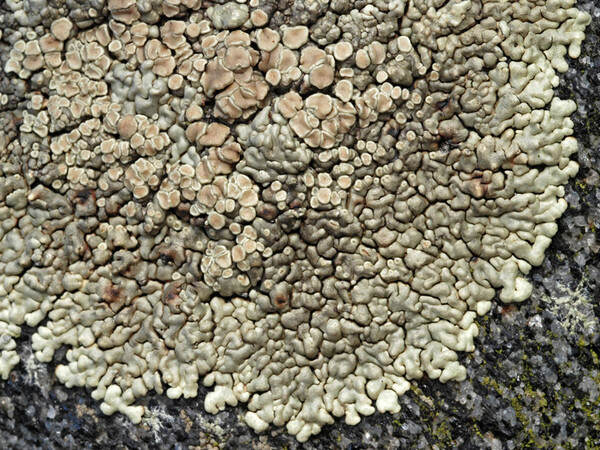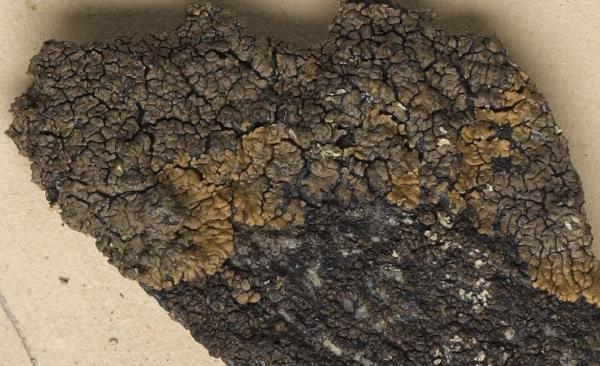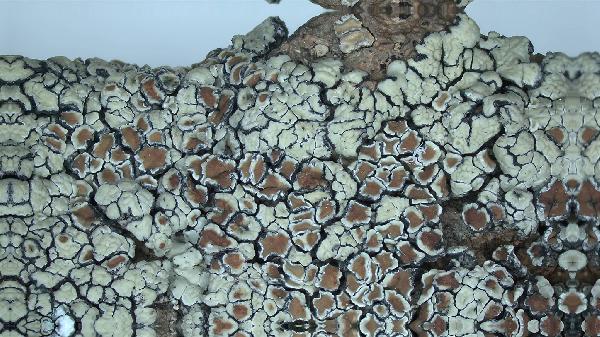Protoparmeliopsis macrocyclos (H. Magn.) Moberg & R. Sant.
in Santesson & al., Lichen-forming and lichenicolous fungi of Fennoscandia: 269, 2004. Basionym: Lecanora muralis var. macrocyclos H. Magn. - Bot. Not.: 115, 1929.
Synonyms: Lecanora macrocyclos (H. Magn.) Degel.; Lecanora muralis subsp. macrocyclos (H. Magn.) Clauzade & Cl. Roux
Distribution: N - Ven, Emil (Fariselli & al. 2020).
Description: Thallus crustose-placodioid, episubstratic, 1-2 mm thick, yellowish green to grey-green, sometimes darker in central parts, usually epruinose, smooth and somewhat shiny, distinctly areolate in central parts, lobed at margins, forming up to 20 cm wide rosettes. Lobes to 5(-10) mm long, 0.5-1.5 mm wide, flat to weakly convex, contiguous to sometimes overlapping, much branched; central areoles flat, angular, 1-2 mm wide, often becoming short- and thin-lobed, giving the central parts of thallus an almost panniform appearance; lower surface corticate, dull whitish to pale brown. Upper cortex 50-75 µm (or more) thick, overlain by an epinecral layer; medulla white, rather loose; lower cortex poorly developed, mostly confined to the tips or margins of lobes. Apothecia usually scarce, lecanorine, 1-1.5(-2) mm across, sessile, with a flat to convex, brown disc and a smooth to crenulate, persistent thalline margin. Thalline exciple corticate, paraplectenchymatous; proper exciple prosoplectenchymatous; epithecium pale yellow to brown, with granular crystals not dissolving in K; hymenium colourless, 60-80 µm high, partially inpsersed with oil droplets, I+ blue; paraphyses coherent, mainly simple or sparingly branched in upper part, the apical cells only scarcely swollen; hypothecium colourless to yellowish. Asci 8-spored, elongate-clavate, very thin-walled, with a K/I+ blue, tall tholus penetrated by a faintly amyloid apical cushion, the wall K/I-, surrounded by a K/I+ blue outer layer, Lecanora-type. Ascospores 1-celled, hyaline, ellipsoid, 9-12 x 5-6 µm. Pycnidia immersed, inconspicuous. Conidia thread-like, 25-42 x 0.7-1 µm. Photobiont chlorococcoid. Spot tests: thallus K- or K+ very pale yellow, C-, KC- or KC+ pale yellow, P- or P+ pale yellow. Chemistry: cortex with usnic acid, medulla with zeorin and different triterpenoids.Note: an arctic-alpine, silicicolous member of the difficult P. muralis-complex, which needs further study. For further details see Timdal (1987).
Growth form: Crustose placodiomorph
Substrata: rocks
Photobiont: green algae other than Trentepohlia
Reproductive strategy: mainly sexual
Poorly known taxon in need of further study
Commonnes-rarity: (info)
Alpine belt: extremely rare
Subalpine belt: extremely rare
Oromediterranean belt: absent
Montane belt: absent
Submediterranean belt: absent
Padanian area: absent
Humid submediterranean belt: absent
Humid mediterranean belt: absent
Dry mediterranean belt: absent

Predictive model
Growth form: Crustose placodiomorph
Substrata: rocks
Photobiont: green algae other than Trentepohlia
Reproductive strategy: mainly sexual
Poorly known taxon in need of further study
Commonnes-rarity: (info)
Alpine belt: extremely rare
Subalpine belt: extremely rare
Oromediterranean belt: absent
Montane belt: absent
Submediterranean belt: absent
Padanian area: absent
Humid submediterranean belt: absent
Humid mediterranean belt: absent
Dry mediterranean belt: absent

Predictive model
 INDEX FUNGORUM
INDEX FUNGORUM
 GBIF
GBIF
 DOLICHENS
DOLICHENS




